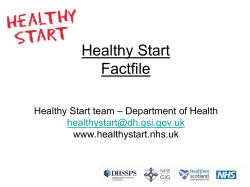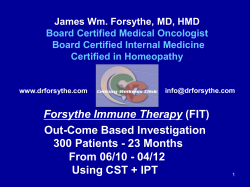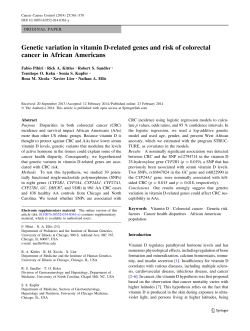
There’s NNo SSuch TThing aas ““Vitamin EE”! Cover Story Introducing the
Preventative Alternative Ayurvedic Holistic Naturopathic Orthomolecular Cover Story Volume 1 Issue 4 January 2000 There is no such thing as “Vitamin E!” Introducing the E Complex Pg.1 New Supplement Review: “P.S.”: Remember to take your Citicoline! Pg.6 Breaking Health News Whey Protein: For Osteoporosis?! Pg.10 A cut above the rest There’s No Such Thing as “Vitamin E”! Introducing the E Complex Holistic International’s and Jarrow Formulas’ hottest new products. Pg. 13 The Bigger Picture A Lectin Epidemic? Pg.14 I want to know! We take your most difficult questions. Pg. 12 Holistic International™ Box: 92 4404 12 Street N.E. Calgary Alberta T2E 6K9 Canada Phone Toll Free 1-800-387-0177 (403)-250-9997 Fax Toll Free 1-877-219-9974 (403)-250-9974 Imagine walking into your local health food store and seeing a bottle on the shelf labeled “Natural Vitamin B.” Not “Natural Vitamin B-Complex” or “Natural Vitamin B-6” -- just “Natural Vitamin B.” You'd be a little puzzled, wouldn't you? Maybe even curious enough to pick up the bottle and see just what the label meant. Next imagine that the ingredients list declared that the product contained just one B vitamin: niacin, say, or pantothenic acid. What would you think? That the supplement was mislabeled? That the manufacturers didn't know what they were doing? That someone was trying to dupe the gullible? After all, you'd think, there's no such thing as “Vitamin B.” Exactly. While there are B vitamins, there is no one molecule that is “vitamin B.” Rather, the B vitamins are a family: the “B complex.” The B complex works as a synergistic whole. You need the full team on your side to enjoy the health benefits of the B complex. Just because you're getting plenty of one B vitamin -- say, riboflavin -doesn't mean that you can forget about thiamine, or folic acid, or the rest. In fact, supplementation with just part of the B complex can even create an artificial deficiency in other B vitamins1. www.Holisticinternational.com e-mail: Holistic@cadvision.com pg.1 The Holistic Lifestyle Volume 1, number 4 January 2000 Executive Editor Dr. Traj P.S. Nibber Editor Michael Rae Graphic Design/Art Production Danika Challand Shebodo@Hotmail.com Copy Editor (Proofing) Cindi Armstrong Holistic International, manufacturers and distributors of the most exciting lines of envelope-pushing nutritional supplements in Canada, welcomes you to this issue of The Holistic Lifestyle, published bimonthly. The Holistic Lifestyle is designed to provide our customers with essential information and news of breakthrough research to help you make the best decisions to meet your health goals through supplements and lifestyle choices. The Holistic Lifestyle also provides news about Holistic International and its products, along with trade shows, retailer information, and government regulations and their impact on your health freedom. Comments? Questions? We want to hear from you! The Holistic Lifestyle c/o Holistic International 4404 - 12 Street N E Box #92 Calgary, Alberta Canada T2E 6K9 The content of this newsletter is provided for informational purposes only, and is not intended as medical advice for individuals, which can only be provided by a healthcare professional. Contents © Holistic International™ and Michael Rae 2000; Design © Danika Challand 2000. pg.2 Most health-conscious people already know all of this. The irony is that nearly every one of us is making the exact same mistake with their "vitamin E." first out” effect: in biological membranes, the tocotrienols are forty to sixty times more potent antioxidants than the tocopherols3. Introducing the E Complex Have a look at your “Natural Vitamin E” supplement. The label probably reads something like this: “d-alpha tocopherol … 400 IU.” That seems perfectly appropriate: that's what vitamin E is -- isn't it? Second, the dose of tocopherols in most “mixed tocopherol” supplements is completely unbalanced. These products contain about six times as much alpha-tocopherol as the other three tocopherols combined. It's now known that taking too much alpha-tocopherol both depletes your body of other E complex vitamins4 and also tends to blunt the other E vitamers’ unique effects5. No, it's not -- anymore than pyridoxine “is” vitamin B. Vitamin E, like “Vitamin B,” is a complex -- a family of eight molecules (four tocopherols and for tocotrienols) which work together in the body to support its health2. Each member of the family (or each “vitamer,” as they’re called) has its own, unique functions. No onefamily member can fully substitute for another. “But,” you say, “my vitamin E says it contains ‘Natural Mixed Tocopherols.’ So my supplement is complete, right?” Unfortunately not -- for two reasons. First, you're still missing a full half of the complex: the tocotrienols. Tocotrienols and tocopherols are very closely-related molecules, but the tocotrienols' unique chemical structures allow them to move around more freely in cell membranes. As a result, tocotrienols can rush in to intercept incoming free radicals more efficiently than can tocopherols. The tocotrienols' greater mobility also allows them to get "recharged" more quickly (by vitamin C and coenzyme Q10) when they fall down in the free-radical fight. This “recharging” effect -- which marks E complex as a part of the body’s five member, elite antioxidant network -- is vital to E vitamins’ antioxidant powers. In fact, when antioxidant recycling fails, E complex vitamins can actually become free radicals themselves, accelerating damage through a process known as tocopherol-mediated peroxidation (TMP)1a. The bottom line on this “first in, So just what can these other vitamin E molecules do that alpha-tocopherol can't? The Blood Pressure Regulator Ever since the 1960s, researchers have been searching for the substance in the body which allows the body to release excess water held in the space between its cells (extracellular fluid). Finding this factor is not just a scientific curiosity, because retaining too much extracellular fluid raises your blood pressure, as well as your risk of congestive heart failure, cardiac fibrosis, and cirrhosis of the liver. The factor was finally identified in 1996: it's a substance called LLU-alpha, which is made in the body from gamma-tocopherol, and nothing else6. E Complex Against Breast Cancer? Two groups of scientists have now reported that delta-tocopherol, as well as all four tocotrienols, can cause breast cancer cells to commit “cellular suicide” in a test tube. Alpha-tocopherol does not have this power7,8, The Smog Protector Peroxynitrite is a vicious free radical which is a major component of smog, and is also responsible for much of the tissue damage caused by the inflammation process. Alpha-tocopherol cannot effectively There is no such thing as Vitamin E! Introducing the E Complex because inflammation is sometimes needed for the body’s immune response. But as people with chronic inflammation from sports injuries or rheumatoid arthritis know, inflammation caused by COX-2 can become a self-perpetuating, vicious circle. If you can block the chronic activation of the COX-2 enzyme, you can inhibit chronic inflammation. Many anti-inflammatory drugs (such as asprin and Non-Steroidal Anti-inflammatory Drugs (NSAIDs)) work because part of their action is to block the activation of COX-2.. remove peroxynitrite without gammatocopherol as a partner.9 Plaque Reversal Double-blind, placebo-controlled trials have shown that high-dose tocotrienol complex can help restore cholesterol balance in people whose levels are too high10. In one such trial, tocotrienols actually reversed the thickening of the arteries leading into the brain in patients with advanced carotid stenosis.11 Alpha-tocopherol alone may be the wrong “Vitamin E” for heart health. COX-2 Inhibitor Cyclo-oxygenase (COX) is an enzyme involved in making the cellular microhormones called eicosanoids. Eicosanoids play a vital role in health, affecting the function of every cell in the body. There are two forms of COX, understandably named COX-1 and COX-2, which are similar in name and structure, but have very Figure 1.23 Corn oil Soybean oil Rice oil Palm oil Olive oil Coconut oil Lard Wheat Wheat germ Wheat bran Corn Oat Rye Rice, white Rice, brown Ricebran Barley Barley bran Unfortunately, these drugs also inhibit the essential COX-1, which is a major part of the reason they cause such side-effects as stomach ulcers and kidney damage: while interfering with the inflammation caused by COX-2, they simultaneously block the vital mainE Complex in Different Food Sources tenance properties Tocopherols (ppm) Tocotrienols (ppm) Total T+T (ppm) of COX-1. New a-T b-T g-T d-T %-T a-T3 b-T3 g-T3 d-T3 %-T3 “COX-2 inhibitor” 122 50 602 18 100 0 782 101 583 264 10 0 958 drugs like celecoxib 125 40 50 22 184 21 570 78 989 (Celebrex®) and 279 61 31 274 398 69 69 1081 ® rofecoxib (Vioxx ) 51 100 0 51 5 6 31 5 1 19 69 36 are designed to 12 7 73 7 27 26 14 7 0 0 36 33 0 0 0 64 59 block COX-2 activi239 90 0 0 72 30 100 0 0 28 459 ty while having less 16 10 0 0 28 13 55 0 0 72 94 effect on COX-1. 6 0 45 0 86 3 0 5 0 14 59 5 16 1 6 6 2 11 1 4 0 1 1 4 16 0 0 1 1 0 0 36 0 0 0 0 8 1 4 32 47 42 35 49 31 42 11 15 1 4 1 11 36 gamma-tocopherol, but not alphatocopherol, is an effective COX-2 inhibitor.14 The important gammatocopherol metabolite, LLU-alpha, was also found to have COX-2 inhibitor powers. The report focuses on work done in test tubes, but the researchers also mention that “the current finding is consistent with our recent [unpublished] observation that g[amma] T[ocopherol] supplementation attenuated inflammation-induced damage in rats.” 2 8 0 0 4 3 25 0 0 2 10 4 2 19 0 0 0 0 6 0 11 68 53 58 65 51 69 58 19 43 4 22 30 23 158 different effects on the body. COX-1 is essential to normal cell function, and is always active in healthy cells: it performs essential "housekeeping” functions, preserving cell health against the ravages of ordinary metabolism. By contrast, COX-2 forms pro-inflammatory eicosanoids, and is thus normally kept in check until it is specifically needed to play its part of the inflammation process. The benefits of blocking COX-2 go beyond fighting pain and easily-detected inflammation. Chronic, low-level inflammation is also involved in the processes of atherosclerosis and carcinogenesis. Many scientists believe -- and randomized, double-blind, placebo-controlled trials are now proving -- that substances which inhibit COX-2 also potently reduce a person's odds of having a heart attack12 and developing various kinds of cancer.13 COX-2 is thus important in the short term, Researchers have recently reported that Which E For the Heart? The winter of 1999-2000 was a big disappointment for many fans of vitamin E. Two large-scale, well-designed studies published in this period -- the HOPE18 and GISSI19 trials -- reported that alphatocopherol (400 IU/day) did not give any protection against new heart attacks to people who had already had one. Numerous objections have been raised against these trials -- most notably the doses used, which may be adequate for healthy people but not for folks who've already had one heart attack -- but the real problem may have been that alphatocopherol alone may be the wrong “vitamin E” for heart health. When you consider all the heart-protective properties of the “other” E vitamins -cholesterol-lowering, anti-inflammatory, blood-pressure reducing, etc. -- you might expect that alpha-tocopherol, administered alone, is not going to be the heart cure-all many people expect it to be. It's interesting, therefore, that several studies have found that low plasma levels of gammatocopherol -- but not alpha tocopherol - area found in patients with Likewise, some atherosclerosis.20,21 studies have found that vitamin E from food, but not supplements, protect women against risk of death from heart disease.22 Interestingly, the most common form of vitamin E in the diet is gamma-tocopherol, while most supplements are overbalanced pg.3 There is no such thing as Vitamin E! Introducing the E Complex with alpha. eight vitamin E molecules. 2. Brigelius-Flohe & Traber. Vitamin E: function and metabolism. FASEB J. 1999 Jul;13(10):1145-55. Saving Brain Cells Our brains have a love/hate relationship with a chemical messenger known as glutamate. Glutamate is a stimulating messenger which is essential for the formation of long-term memories. Unfortunately, it can be too stimulating: excessive glutamate can lead to brain cell death, and research suggests that abnormal glutamate metabolism plays a major part in the loss of neurons in Parkinson's15 and Alzheimer's16 diseases. This guideline matches reccomendations made by scientists like Dr. Lester Packer, head of the Packer Lab studying antioxidants at UC Berkeley; Dr. Andreas Papas, Senior Scientific Advisor to the Cancer Prevention Group at the Harvard School of Public Health; and Dr. Roy Walford, the world's greatest authority on the anti-aging effects of caloric restriction, and Professor Emeritus of Pathology at UCLA. 3. Serbinova et al. Free radical recycling and intramembrane mobility in the antioxidant properties of alpha-tocopherol and alpha-tocotrienol. Free Radic Biol Med. 1991;10(5):263-75. Scientists tested members of the E complex to see what effect they would have on brain cells exposed to glutamate in a test tube. They found that alpha-tocotrienol, but not alpha-tocopherol, could block brain cell death caused by glutamate.17 Interestingly, the effect was caused by an unique mechanism involving alphatocotrienol’s effects on brain cells’ internal messenger systems, rather than the its antioxidant properties. The Tip of the Iceberg Researchers have only begun to explore the properties of the “missing” E complex vitamins, so even more exciting discoveries may be just around the corner. For instance, researchers recently reported that tocotrienols can extend the average lifespan of flatworms;18 what might this bode for mammals? Dosage, Ratios, Synergy Make sure your vitamin E arsenal is complete. The exact, ideal proportions of the E complex members required for optimal health has not yet been worked out, but the rule of thumb is that for every IU of alpha-tocopherol you take, you need roughly an equal number of milligrams of other tocopherols and tocotrienols combined. That is, if you're taking 400 IU of alpha-tocopherol, you should be taking between 300 and 500 milligrams of other tocopherols plus tocotrienols, including all pg.4 A complete, balanced vitamin E supplement program must provide all eight vitamin E molecules: alpha-, beta-, gamma-, and delta- tocopherols and tocotrienols. Further, the E vitamers must be present in a balanced ratio -- either balanced in itself, or formulated to balance out the heavy alpha-tocopherol content of most multivitamins and “vitamin E” supplements. People taking E-complex vitamins should also ensure that they are getting enough vitamin C and Coenzyme Q10, because (as noted above) these nutrients play a vital role in “recharging” E vitamins to their active antioxidant form when they are deactivated in the battle against free radicals. Vitamin E is an orchestra, not a soloist: eight molecules, not one. Keep Up to Date! Dr. Andreas Papas, author of the invaluable The Vitamin E Factor (HarperCollins, June 1999), maintains a website devoted to the complete vitamin E complex, and includes regular updates on breaking research news. Follow the latest discoveries at: http://www.vitamine-factor.com References 1. Ballmer. Vitamins and metals: possible hazards for humans. Schweiz Med Wochenschr. 1996 Apr 13;126(15):607-11. 1a. Upston et al. Tocopherol-mediated peroxidation of lipoproteins: implications for vitamin E as a potential antiatherogenic supplement. FASEB J. 1999 Jun;13(9):977-94. 4. Handelman et al. Oral alpha-tocopherol supplements decrease plasma gamma-tocopherol levels in humans. J Nutr. 1985 Jun;115(6):80713. 5. Qureshi et al. Dietary alpha-tocopherol attenuates the impact of gamma-tocotrienol on hepatic 3-hydroxy-3-methylglutaryl coenzyme A reductase activity in chickens. J Nutr. 1996 Feb;126(2):389-94. 6. Wechter et al. A new endogenous natriuretic factor: LLU-alpha. PNAS. 1996 Jun 11;93(12):6002-7. 7. Yu et al. Induction of apoptosis in human breast cancer cells by tocopherols and tocotrienols. Nutr Cancer. 1999;33(1):26-32. 8. McIntyre et al. Antiproliferative and apoptotic effects of tocopherols and tocotrienols on normal mouse mammary epithelial cells. Lipids. 2000 Feb;35(2):17180. 9. Christen et al. Gamma-tocopherol traps mutagenic electrophiles such as NO(X) and complements alpha-tocopherol: physiological implications. PNAS. 1997 Apr 1;94(7):3217-22. 10. Qureshi et al. Response of hypercholesterolemic subjects to administration of tocotrienols. Lipids. 1995 Dec;30(12):1171-7. 11. Tomeo et al. Antioxidant effects of tocotrienols in patients with hyperlipidemia and carotid stenosis. Lipids. 1995 Dec;30(12):1179-83. 12. Steering Committee of the Physicians' Health Study Research Group. Final report on the aspirin component of the ongoing Physicians' Health Study. N Engl J Med. 1989 Jul 20;321(3):129-35. 13. Giovannucci et al. Aspirin use and the risk for colorectal cancer and adenoma in male health professionals. Ann Intern Med. 1994 Aug 15;121(4):241-6. 14. Jiang et al. Gamma-Tocopherol and its major metabolite, in contrast to alpha -tocopherol, inhibit cyclooxygenase activity in macrophages and epithelial cells. PNAS. 2000 Sep 72 (Early Edition); 1-6. 15. Plaitakis & Shashidharan . Glutamate transport and metabolism in dopaminergic neurons of substantia nigra: implications for the pathogenesis of Parkinson's disease. J Neurol. 2000 Apr;247 Suppl 2:II2535. 15. Harkany et al. beta-Amyloid excitotoxicity in rat magnocellular nucleus basalis. Effect of cortical deafferentation on cerebral blood flow regulation and implications for Alzheimer's disease. Ann N Y Acad Sci. 2000 Apr;903:3 16. Sen et al. Molecular basis of vitamin E action. Tocotrienol potently inhibits glutamate-induced pp60(c-Src) kinase activation and death of HT4 neuronal cells. J Biol Chem. 2000 Apr 28;275(17):13049-55. 17. Adachi & Ishii. Effects of tocotrienols on life span and protein carbonylation in Caenorhabditis elegans. J Gerontol A Biol Sci Med Sci. 2000 Jun;55(6):B280-5. 18. Yusuf S, Dagenais G, Pogue J, Bosch J, Sleight P. Vitamin E supplementation and cardiovascular events in high-risk patients. N Engl J Med. 2000 Jan 20;342(3):154-60. 19. Gruppo Italiano per lo Studio della Sopravvivenza nell'Infarto miocardico.Dietary supplementation with n-3 polyunsaturated fatty acids and vitamin E after myocardial infarction: results of the GISSI-Prevenzione trial. Lancet. 1999 Aug 7;354(9177):447-55.
© Copyright 2025





















